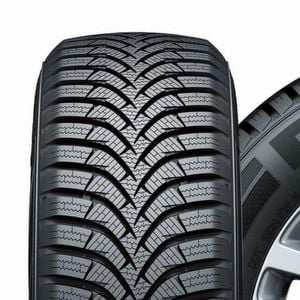Last Updated on 17.12.2024 by hrushetskyy

What are tractor tires?
Tractor tires are essential farm equipment. These specialized tires are built for machinery like tractors, combines, sprayers, and harvesters. They are engineered to provide optimal performance in various farming conditions, including soft soil, mud, and uneven terrains. When you operate heavy farm machinery, you need superior traction, impeccable performance, and excellent stability. And farm tires deliver on all fronts.
Why is a farm tire so important in agriculture?
These giants bring undeniable benefits to the agricultural environment. First of all, tractor tires are about high stability and improved traction—essential features for maneuvering heavy equipment in various terrains without slipping or getting stuck. They offer fuel efficiency and help reduce machinery wear. A properly fit farm tire takes part in soil preservation, minimizing its compaction and maintaining its natural structure for better crop yields. And, of course, quality tires reduce the risk of accidents due to tire failure or loss of control, which is so important in heavy machinery.
Key features of a tractor tire
Tread design
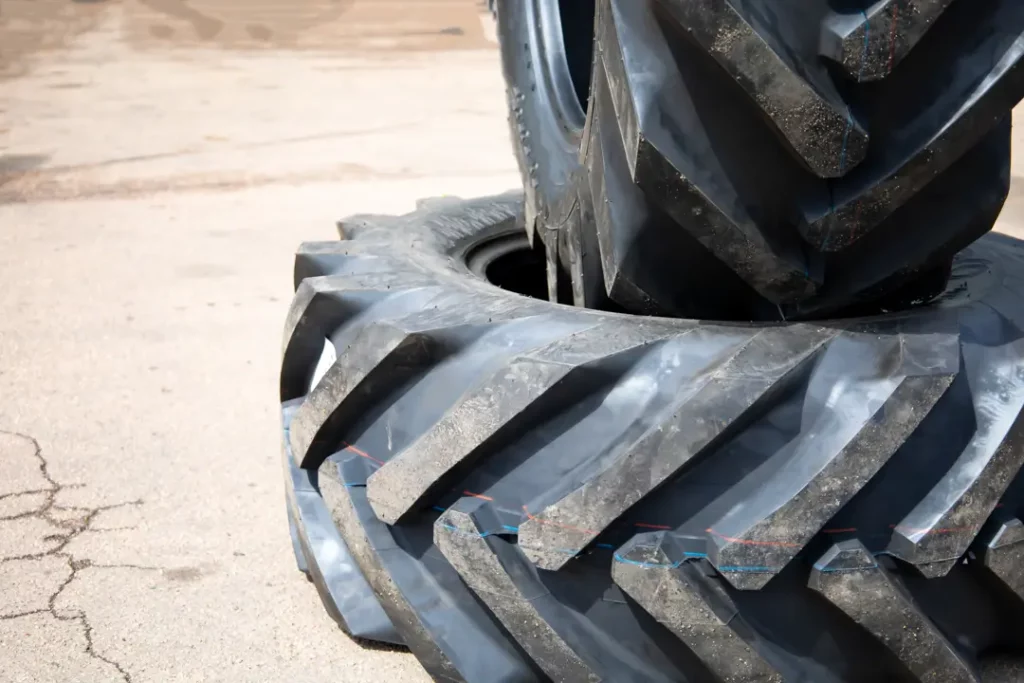
Deep lugs: Farm tires typically feature deep, angled lugs (aka bars) that dig into the soil, providing excellent traction and minimizing slippage.
Self-cleaning: The tread patterns are designed to shed mud and debris, maintain grip, and prevent buildup that could hinder performance.
Construction types
Bias-ply tires
Constructed with layers of rubber-coated plies placed diagonally across each other. They offer strong sidewalls and are generally more affordable. The plies intersect at angles typically ranging from 30 to 40 degrees, which provides flexibility. The construction results in a thicker sidewall and crown, which are interdependent. This flexibility offers a smoother ride on rough terrains but generally results in lower traction and control, especially at higher speeds. The internal cords, running from bead to bead, consist of materials such as nylon or polyester and are bound to the rim with tensile steel wire, forming the bead.
Belted bias tires
Built with steel belts running at a 90-degree angle to the tread direction. They provide better traction, fuel efficiency, and a smoother ride due to flexible sidewalls. Similar in construction to bias-ply tires, belted bias tires include additional stabilizing belts, often made of fabric or steel, positioned beneath the tread. These belts are placed at different angles than the primary plies, enhancing the tire’s performance. This structure reduces rolling resistance and improves ride comfort and stability at higher speeds compared to standard bias-ply tires, though they still retain some of the limitations in traction and control.
Radial tires
Unlike bias and belted bias tires, radial tires feature plies that run perpendicularly (at 90-degree angles) to the direction of travel across the tread. The cords within radial tires are placed parallel to each other rather than crisscrossing. Beneath the tread, stabilizer belts, often made of steel, reinforce the tire. This design enhances durability, traction, and control, particularly at high speeds, and minimizes rolling resistance. However, radial tires may deliver a slightly rougher ride at lower speeds and are less effective in self-cleaning debris due to their tread pattern, which is optimized for performance and efficiency on firm surfaces.
Flotation tires
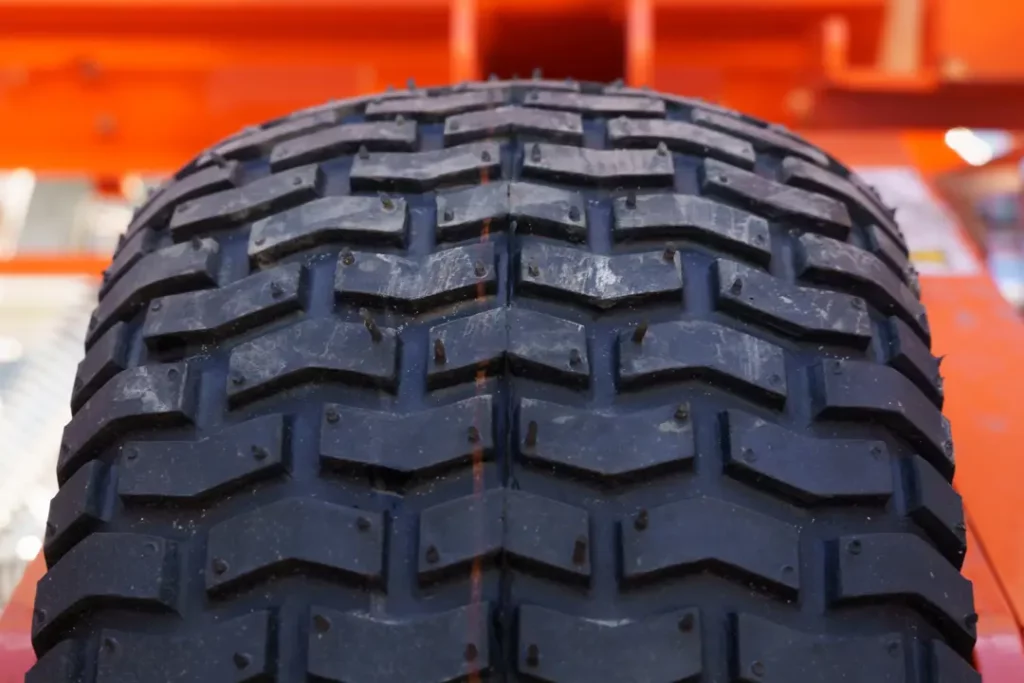
Flotation tires are designed with a wider footprint to distribute weight more evenly across the ground.
They offer excellent stability and flotation and reduce soil compaction, being an ideal choice for soft, wet, or sandy soils. Flotation tractor tires are commonly used in applications like spreading, spraying, and harvesting in sensitive soil conditions.
Row crop tires
Row crop tractor tires are narrower, so they fit between rows of crops without damaging plants. They provide excellent traction and control for precision tasks between crop rows and are primarily used for cultivating and other operations that require working between planted rows.
Implement tires
Often simpler in design, implement tires are suited for non-driven wheels on implements and equipment.
They are designed for stability and durability and are mostly used on agricultural machinery such as trailers, balers, and other equipment where traction is less critical.
What is better, bias ply or radial tire?
A bias-ply tractor tire is more flexible, providing a comfortable and smoother ride, especially on rough terrain. However, these tires generally offer less traction and can be harder to control at higher speeds. Radial tires, on the other hand, strengthen the tire structure and extend tire life. They provide better control and reduced rolling resistance at high speeds, making them more efficient for such conditions. However, radial tires might feel rougher at lower speeds and have less effective self-cleaning properties.
Regarding self-cleaning capabilities, radial tires typically have tread patterns designed to shed mud and debris to some extent, but they may not be as effective as bias tires with deeper, more open tread patterns specifically designed for self-cleaning. Self-cleaning is important in off-road and agricultural contexts to maintain traction and prevent slippage.
Load capacity and sizes
Designed to support heavy machinery and loads, these tires come in various sizes and ply ratings to match specific equipment requirements.
Soil compaction reduction
Some farm tires are wider or have special designs to distribute the weight of the equipment over a larger area, reducing soil compaction and preserving soil health.
Tractor tire and fuel consumption
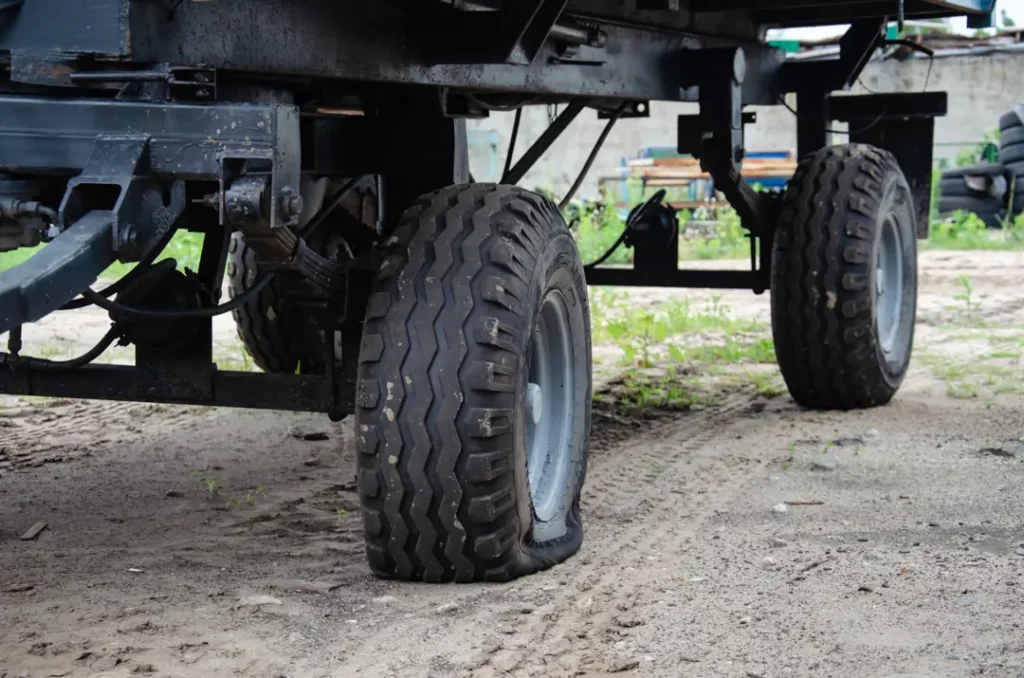
Key factors influencing fuel efficiency:
Tire pressure
Underinflated tires create more rolling resistance, requiring more fuel. Overinflated tires reduce traction and increase slippage, especially in soft soils, wasting energy. Properly inflated tires reduce rolling resistance and maximize fuel efficiency.
Tire type
Radial tires, with their flexible sidewalls and larger contact area, improve traction and reduce fuel usage compared to bias-ply tires. Specialized low-pressure tires distribute weight more evenly, reducing soil compaction and fuel usage in field operations.
Traction and slippage
Poor traction or excessive wheel slippage increases fuel consumption as energy is wasted in maintaining movement. Deep, well-maintained tread patterns enhance grip, offer high flotation and reduce slippage, saving fuel.
Soil conditions and weight distribution
Tires designed to minimize soil compaction ensure the tractor operates efficiently, especially in soft or uneven terrain. Balancing load distribution can improve fuel efficiency by using ballast or adjusting tire configurations.
6 types of farm tires: a complete range
- R1 (Agricultural Lug): Standard tractor tires suitable for general farming tasks on dry land.
- R1W (Deep Tread): Similar to R-1 but with deeper treads for better performance in wet or muddy conditions.
- R2 (Rice and Cane): Extremely deep tread, ideal for very wet and swampy conditions like rice fields.
- R3 (Turf Tires): Shallow tread depth and wide footprint to minimize damage to grass and delicate surfaces; used on lawns and golf courses.
- R4 (Industrial Tires): Intermediate tread, used for light construction and industrial applications; suitable for hard surfaces.
- VF Tires (Very High Flection): Advanced agricultural tires designed to carry heavier loads at lower pressures. They reduce soil compaction by distributing weight over a larger area, which is the key factor for maintaining soil health and crop yields. The flexibility of these tires improves traction and efficiency on challenging terrains. It minimizes slippage and saves fuel. Despite the flexibility, they are durable and long-lasting.
How to keep your tractor tires in good condition

Heavy machinery equipped with tractor tires drives the construction and agricultural industries forward. Tractors are designed to provide high traction power, enabling them to haul agricultural and construction materials, operate machinery, and power other mechanized farm and construction equipment.
- Check tire pressure regularly
Maintain the recommended air pressure as specified by the manufacturer.
Use a reliable pressure gauge and adjust for load and terrain conditions. Underinflation can lead to excessive wear, while overinflation can cause reduced traction and increase the risk of damage.
- Inspect for damage
Regularly check for cuts, cracks, punctures, or bulges on the tire surface and sidewalls. Address minor damage promptly to prevent it from worsening.
- Clean tires after use
Remove mud, debris, or chemicals from the tire surface to prevent corrosion or weakening of the rubber.
Wash tires with water and mild soap, especially after working in fields treated with fertilizers or pesticides.
- Monitor tread wear
Inspect the tread depth and look for uneven wear patterns.
Replace tires when the tread is too worn to ensure optimal traction and safety.
- Avoid overloading
Ensure the load does not exceed the tire’s weight capacity to prevent structural damage.
Distribute weight evenly across the tractor to reduce stress on individual tires.
- Store tires properly
If tires are not in use, store them in a cool, dry place away from direct sunlight and heat sources to prevent degradation.
Use tire covers or store them indoors to protect against UV damage.
- Rotate tires periodically
If possible, rotate the front and rear tires to even out wear patterns and extend their lifespan.
- Use ballast for stability
Proper ballast can reduce tire slippage, distribute weight effectively, and extend tire life, especially for heavy-duty tasks.
How can you tell that your tractor tires need to be replaced?
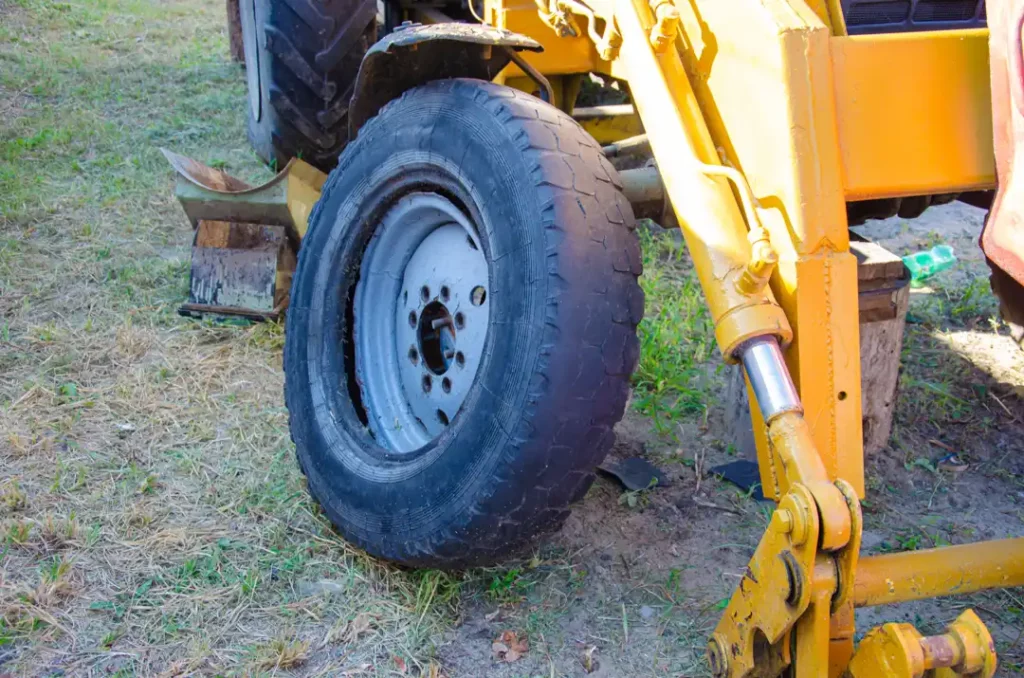
Modern tractor tires are sometimes equipped with tread wear indicators to help assess their condition. For older tires, you can evaluate how effectively the tractor tire lugs are pushing dirt backward as an informal wear indicator. Increased slippage or reduced traction might suggest it’s time to inspect your tires more closely for replacement. Proper tire maintenance is crucial for recognizing when replacements are necessary. Signs of a tractor tire in need of replacement include:
Cuts or bulges on the tire surface: If your tractor tires show cuts, punctures, or bulges, these defects are often caused by impacts or rough terrain and should be addressed immediately to prevent delays or accidents.
Deflated tire: Underinflation, or lack of sufficient air pressure, can lead to deflation, making the sidewall vulnerable to damage. It’s crucial to maintain the recommended tire pressure as specified by the manufacturer to avoid such issues.
Cracks due to dryness: Over time, tire materials can dry out and harden, leading to cracks. These cracks compromise the tire’s flexibility and can eventually cause tread separation if left unchecked.
Uneven wear: One-shoulder wear: Occurs when the tire is misaligned, causing more pressure on one shoulder. Two-shoulder wear: Results from underinflation, where the outer parts of the tread experience excessive contact with the ground. Center wear: Indicative of overinflation, where the central part of the tread wears faster.
The best brands and models of farm tires
Global demand for tractor tires
Off-the-road (OTR) tires market is projected to increase at a CAGR of 4.64 percent from 2017 to 2025, according to a research. This demand amounts to approximately US$7.68 billion by 2025, from US$5.34 billion in 2017. OTR tires cover that which is used in construction and mining equipment, agricultural tractors and industrial equipment.
The demand for tractor tires is also growing significantly, according to the report of the Global Agriculture Tractor Tires Market – Strategic Assessment and Forecast 2017-2022. Analysts say the tractor tires market is expected to grow at 5.06 percent (compound annual growth rate (CAGR) in terms of shipment from 2016 to 2022.
| Rank | Exporter | 2017 Rubber Tires Exports | % World Total |
| 1. | China | US$14.2 billion | 19% |
| 2. | Germany | $5.9 billion | 7.9% |
| 3. | Japan | $4.8 billion | 6.5% |
| 4. | The United States | $4.7 billion | 6.2% |
| 5. | Thailand | $4.4 billion | 5.9% |
| 6. | South Korea | $3.4 billion | 4.6% |
| 7. | Netherlands | $2.6 billion | 3.5% |
| 8. | France | $2.5 billion | 3.4% |
| 9. | Poland | $2.1 billion | 2.9% |
| 10. | Spain | $2.1 billion | 2.8% |
Source: World’s Top Exports
The increasing farm mechanization in developing countries like those in the African continent, India, Thailand, and China will continue to boost the demand for agricultural tractor tires.
The demand for radial-ply tires from developed countries like those in Europe and North America is expected to grow. Developed countries demand highly technically advanced tires.
Are used tractor tires Okay to buy?
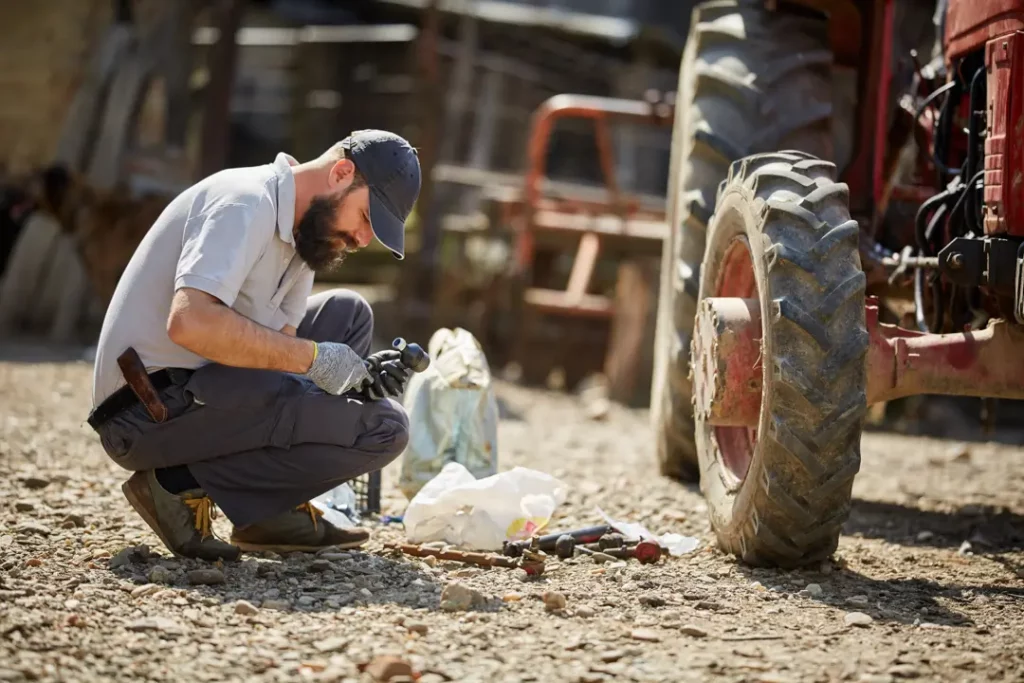
If you need to replace your tractor tires, buying a new one might not be an easy option, especially since it is very expensive. How much do tractor tires cost? A radial-design tractor tire from Titan Tire Corporation has an average retail price of US$1,600 to US$2,900. Some new tires might come cheaper at US$400, but still, it costs a fortune for many.
Buying used tractor tires will save you from breaking the bank. Used tractor tires will not be damaged anytime soon. How much do used tractor tires cost, you ask? If your tractor only has one damaged tire, you can get a new tire for as low as US$50. However, the price depends on how well the tires were preserved. Make sure that you are able to check the tread wear and age of the used tires you are buying to make sure that they will still last you for several more years.
If you lack the money to buy even used tractor tires, don’t forget that selling your used tractor tire can give you additional funds, too. Even if your tractor tire is really damaged or flat, there are interested buyers who want to repurpose old tractor tires and turn them into equipment or accessories for a gym, furniture, or playground.
Frequently Asked Questions
Why tractor tires are so important?
Tractor tires are key to the success of most farming operations. They provide traction, minimize soil compaction, and support heavy loads.
How to choose the best farm tires?
Choose a reliable tire retailer with extensive experience and positive reviews. Save big by buying used tractor tires at Utires.com and get them delivered right to your farmlands for free by FedEx.
Can I buy used tractor tires?
Yes, used tractor tires are a great choice. You can buy them in perfect, close-to-new condition and save up to 50% and more from the original price.
How much are used tractor tires?
Prices range from approximately $250 for smaller tires to over $2,000 for larger, high-quality ones. The final price will vary depending on tire condition, brand, model, and year.
Are used tractor tires safe?
Yes, if you buy them from a reputable retailer.
Share the Knowledge
